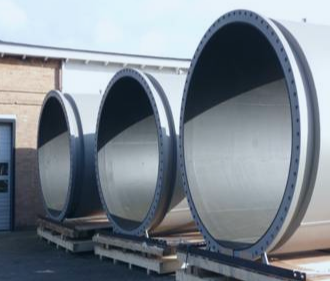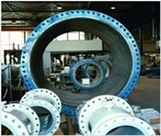|
The
World Market for Magnetic Flowmeters, 7th Edition
 This important 526-page study reveals the size
of the worldwide magnetic flowmeter market, including the market shares of all major suppliers, and
forecasts the market through 2024. The study provides: This important 526-page study reveals the size
of the worldwide magnetic flowmeter market, including the market shares of all major suppliers, and
forecasts the market through 2024. The study provides:
• 2019 and 2020 market size in US dollars and unit volume for magnetic
flowmeters worldwide market data for 2021
• Market shares of the leading suppliers of magnetic flowmeters worldwide
• Forecast of the growth market for magnetic flowmeters in dollars and
unit volumes through 2024
• Segmented data both on a worldwide basis and for each of 8 global
regions
• Product analysis for all of the primary suppliers selling into the
magnetic flowmeter market
• Industries and applications where magnetic flowmeters are used,
including market growth sectors
• Market and product strategies for suppliers of magnetic flowmeters
worldwide
• Company profiles for the significant suppliers of magnetic flowmeters
worldwide
Magnetic flowmeters, among the
most widely used types of flowmeters for measuring the flow of water and
other liquids, have been around for more than 50 years. The
Tobinmeter Company first introduced magnetic flowmeters for commercial use
in Holland in 1952. Foxboro (now part of Schneider Electric)
introduced them to the United States in 1954. Since this time, more
than 60 suppliers worldwide have come to offer magnetic flowmeters for
sale.
#1 in revenues
Magnetic flowmeters generate more
revenues worldwide than any other type of flowmeter. The story is
different in terms of units, however. More positive displacement,
turbine, DP, and variable area flowmeters are sold annually. Despite
this, the higher average selling price of magnetic flowmeters enables them
to generate more revenues annually.
Magnetic flowmeters are most
widely used in the water & wastewater and chemical industries, which
generate about half of magmeter revenues. Mageters are also
widely used in the food & beverage and pharmaceutical industries, which
often require flowmeters to conform to sanitary requirements. Flowmeter
suppliers meet these requirements in part by placing sanitary liners inside
the meters.
Greater conductivity
The inability of magnetic
flowmeters to measure nonconductive liquids will always be a barrier to
their use in the oil & gas and refining industries, barring some
unforeseen technological breakthrough. However, suppliers have succeeded in
reducing the amount of conductivity required to measure flow, in part by
boosting the amount of power used to excite the magnetic coils, thereby
creating a stronger signal. By pushing back the boundaries of
conductivity, suppliers are making magnetic flowmeters usable in a broader
range of applications.
Popular in Europe
Magnetic flowmeters
are especially popular in Europe, where they were first introduced and
where the top three magnetic flowmeter suppliers today are based. Water is
a highly valued resource in Europe, and magmeters are widely used to
measure the flow of water. Food processing and pulp & paper are both
very prevalent industries in Europe, and magmeters are heavily used in both
of these industries.
Europeans also seem to show a
preference for spoolpiece over clamp-on meters, and most magnetic
flowmeters are of the inline type, whether wafer or flanged. There are no
clamp-on magnetic meters, but there are clamp-on ultrasonic meters, and
ultrasonic meters are an alternative to magmeters for some applications.
Learn more
about New-Technology Flowmeters:

Future Development
Measuring
Liquids with Lower Conductivity Values
 Through making
magnetic flowmeters better at measuring liquids with lower conductivity
values, magnetic flowmeter suppliers have reduced the market share of
Doppler meters. More complex software and more recent signal processing
techniques have contributed to some of this achievement. Research in this
field is currently underway, thus it is to be expected that vendors will be
able to test liquids with ever-lower conductivity in the future. However,
no magnetic flowmeter capable of measuring the flow of hydrocarbons has yet
been created. Through making
magnetic flowmeters better at measuring liquids with lower conductivity
values, magnetic flowmeter suppliers have reduced the market share of
Doppler meters. More complex software and more recent signal processing
techniques have contributed to some of this achievement. Research in this
field is currently underway, thus it is to be expected that vendors will be
able to test liquids with ever-lower conductivity in the future. However,
no magnetic flowmeter capable of measuring the flow of hydrocarbons has yet
been created.
Liners -- the 'secret sauce' of
magnetic flowmeters
Liners enables magmeters to
measure both very dirty and very clean liquids. With the appropriate liner
option, they can measure the dirty liquids and slurries common to the pulp
& paper and wastewater industries, as well as the hygienic and sanitary
liquids common to the food & beverage and pharmaceutical industries.
Of the nine main types of liners
for magnetic flowmeters the most dominant are PFA (perfluoroalkoxy), PTFE (polytetrafluoroethylene)
-- Teflon® is a familiar trade name for PTFE made by DuPont -- and hard
rubber. Hard rubber is widely used for water & wastewater applications.
Liners increase magnetic
flowmeters' durability and reliability, and make it possible to use them
with almost any type of liquid. No other flowmeter that measures liquids
has such versatility when it comes to the material in the flowmeter that
makes contact with the liquid.
The
"secret ingredient" in magnetic flowmeters comprises liners.
There are currently a lot of different liners available. Liners are
particularly useful for wastewater applications as well as sanitary ones.
Notwithstanding all the advancements so far, new types of liners should
continue to be developed as magnetic flowmeters find new applications .
A Continued
Focus on Market Strengths
In
their core competencies—liquid measurement in the water & wastewater,
chemical, food & beverage, pharmaceutical, and biotech
industries—magnetic flowmeters are widely used. Due to their capacity to
incorporate sanitary-friendly liners, they excel at sanitary applications
and can handle practically any line size, from the very small to the very
big. While magnetic flowmeters have a sizable installed base and there does
not appear to be a substantial shift to alternative technologies,
ultrasonic and differential pressure flowmeters offer alternatives for
particular applications.
Given
the prominence of magnetic flowmeters in the aforementioned industries, one
area of study is to concentrate on creating new goods especially for these
sectors. One possibility is to combine a magnetic flowmeter with a control
valve to offer both measurement and control. Another is to pay closer
attention to the requirements of the beverage sector, particularly those of
breweries and microbreweries that already employ both magnetic and Coriolis
meters. In the smaller line sizes, magnetic flowmeters do compete with
Coriolis meters, but they are more affordable in these applications. For a
magnetic flowmeter company looking to expand its market share, creating
specialized solutions for applications in the five industries outlined
above that may include extra instrumentation could be the key to success.

For
further information, including detailed market reports, please see www.FlowMags.com.
|